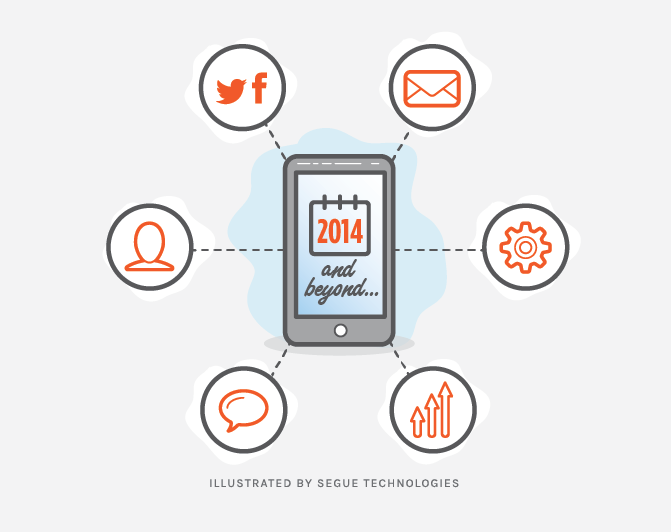We’ve seen a lively media focus on health IT in recent weeks, largely focused on the rocky launch of the healthcare.gov website. Industry insiders and the public are certainly aware of the influence technology has on the delivery of healthcare. So what big trends will influence Health IT in 2014?
Big Data — Big Problem
Many of the goals of healthcare reform rely on the capability to capture and manage unprecedented amounts of data. Yet organizations continue to struggle to both effectively manage the IT demands of Big Data, and develop a clear business case for how to deploy it. Then, as the data from Electronic Health Records and other clinical sources piles up, data is also arriving from new sources: the Internet, mobile health, social media, and patients themselves. The result can be a mass of information that isn’t contributing to strategic goals. Organizations are working to capture and convert clinical and administrative data into actionable information and create value.
Advances in virtual storage are helping to organize Big Data, and organizations are getting smarter about establishing a strategy of prioritization and appropriate data inputs. It is clear that in 2014, Big Data isn’t going away, and neglecting to create such strategies to manage it will only make the inevitable pile of information worse. Organizations need to focus on eliminating duplication, assessing what is and isn’t necessary, and segmenting and prioritizing the remaining data. The payoff is exciting; according to a recent McKinsey analysis, if the nation’s healthcare system were to use these Big Data sets creatively and effectively, the sector could create more than $300 billion annually in value.
Mobile, Mobile, Mobile
The explosion of mobile devices and applications will continue as innovative new products are developed and daily use increases. Consumers in every sphere will continue to expect a focus on mobile and a seamless connection between computing and communicating. Security will be of increasing concern. HealthITSecurity predicts that there will be a significant increase in malware for the Android operating system, and malware will begin to affect iOS as well (learn more about protecting your mobile data here). However, while this anytime, anyplace flow of information can present challenges, such as security issues and enabling content regardless of platform or device, the trend for continued reliance on mobile will continue in the foreseeable future.
Social Media
Social media will continue to change how health organizations interact with patients and with each other, which will drive new business models for healthcare companies. Consider some of the following statistics: more than 40% of consumers say that information found via social media affects the way they deal with their health. In addition, 90% of respondents from 18 to 24 years of age said they would trust medical information shared by others on their social media networks. Providers need to be engaged to ensure that there is reliable, accurate content available that is reaching the right audience, yet only 31% of healthcare organizations have specific social media guidelines in writing. It is clear that most health providers remain confused on how to better leverage social media to benefit their organizations and their patients. It is vital to create social media guidance and strategy that defines activity and limitations for everyone in an organization. The increasingly digital-savvy health workforce will also support this demand for social media.
Interoperability
Healthcare will continue to become more networked. Meaningful Use requirements demand that Electronic Health Records (EHRs) interface with labs, imaging centers, referrals and patients, but problems still exist. As one pundit notes, the biggest roadblock to true health data interoperability isn’t a lack of standardization, but “the fact that there are too many standards with no harmonization.” Others have indicated that successful interoperability is less about fine-tuning technology and more about removing cultural barriers that treat data as the property of the provider or the institution, not the patient or the public. Traditional reimbursement models have actually encouraged this proprietary approach; if a patient’s previous medical data is unavailable, a provider can legitimately repeat tests or procedures and then bill for them. However, work is being done to redesign Medicare reimbursement, which will influence commercial insurers. The barriers, whether technological or cultural, are quickly being removed and interoperability will remain a strategic focus.
Consumer Demand
As the Affordable Care Act (ACA) has changed consumer awareness and interaction with the pricing of health insurance, patients are increasingly engaged in understanding the costs associated with their healthcare. The traditional “consumer ignorance” of payers and providers is giving way to a more engaged, questioning patient. Demand for price transparency continues to grow and will be fueled by new health insurance exchanges. Savvy organizations will regard transparency as a priority in negotiations with health plans and providers. As quoted in the report Empowering Individuals to be Better Healthcare Consumers, “The market leaders that emerge will be those who are able to close the information gap between buyers and sellers and act more like these leading retailers and financial firms in their ability to understand and meet unique consumer needs and preferences.”
Overall outlook for 2014? Challenges remain – privacy, security – but the possibilities for the better delivery of health through IT continue to grow. Consumers will enjoy increased opportunities to get into the driver’s seat and take control of their own health.
